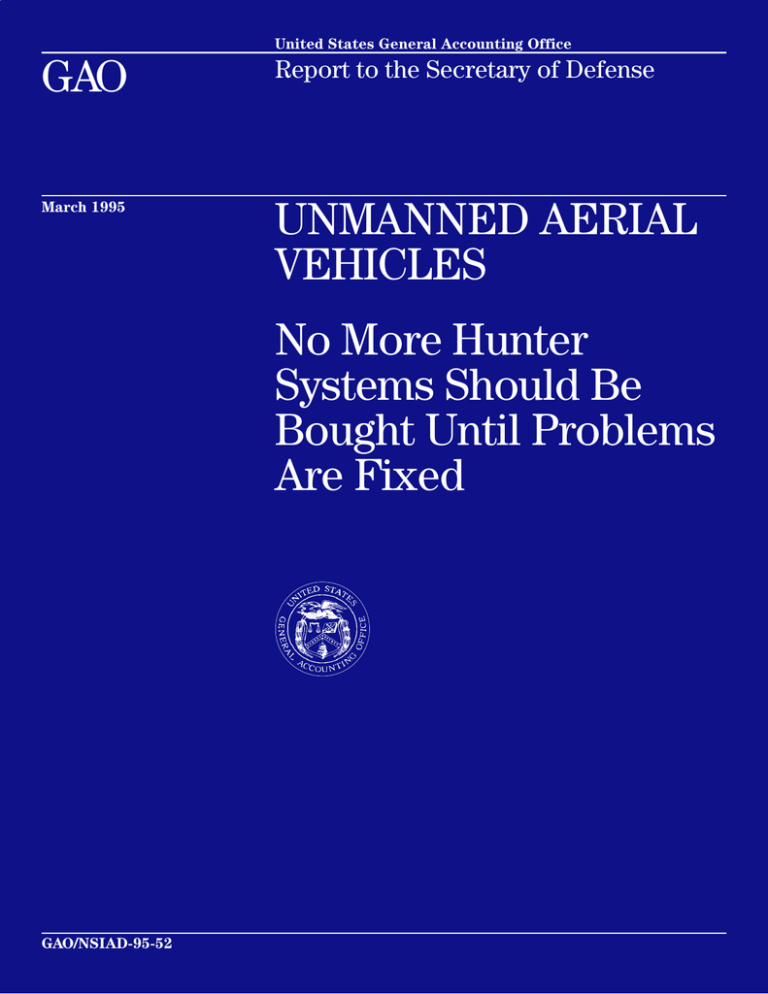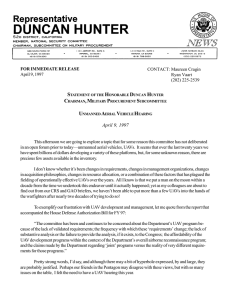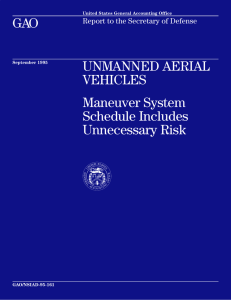GAO UNMANNED AERIAL VEHICLES No More Hunter
advertisement

United States General Accounting Office GAO Report to the Secretary of Defense March 1995 UNMANNED AERIAL VEHICLES No More Hunter Systems Should Be Bought Until Problems Are Fixed GAO/NSIAD-95-52 GAO United States General Accounting Office Washington, D.C. 20548 National Security and International Affairs Division B-259256 March 1, 1995 The Honorable William J. Perry The Secretary of Defense Dear Mr. Secretary: The Department of Defense (DOD) is acquiring the Hunter Short-Range Unmanned Aerial Vehicle (UAV) for use by the Army, the Navy, and the Marine Corps at an estimated cost of over $4 billion. We reviewed the Hunter program to determine (1) whether it has been demonstrated to be logistically supportable, (2) whether its performance deficiencies found in prior testing have been resolved, and (3) whether it represents a valid joint-service effort as mandated by Congress. Background The Hunter is a pilotless aircraft resembling a small airplane that is controlled from a ground station. (See fig. 1.) It is intended to perform reconnaissance, target acquisition, and other military missions by flying over enemy territory and transmitting video imagery back to ground stations for use by military commanders. The Hunter program (formerly called the Short-Range UAV program) began in 1989 as a joint-service effort in response to congressional concern over the proliferation of UAVs by the different services and the need to acquire UAVs that could meet the requirements of more than one service. DOD started the program by procuring two candidate systems for competitive testing. In early 1993, after the Hunter was selected as the winning system, DOD approved its low-rate initial production of seven systems and awarded a $171-million contract. Page 1 GAO/NSIAD-95-52 Unmanned Aerial Vehicles B-259256 Figure 1: Hunter UAV: Wingspan 29’ Length 23’ Each system includes eight UAVs with payloads, a launch and recovery station, ground stations for controlling flight and processing information from the UAVs, and other related equipment. (See fig. 2.) DOD plans to buy 24 systems for the Army, 18 for the Navy, 5 for the Marine Corps, and 3 for training, for a total of 50 systems. Page 2 GAO/NSIAD-95-52 Unmanned Aerial Vehicles B-259256 Figure 2: Hunter UAV System Page 3 GAO/NSIAD-95-52 Unmanned Aerial Vehicles B-259256 Results in Brief To date, the Hunter UAV system has shown itself to be logistically unsupportable, and tests have identified serious performance problems that adversely impact the system’s effectiveness. Based on its performance to date, the system may prove unsuitable for use by operational forces and, contrary to DOD plans, could require costly contractor maintenance and support to keep it operating. Furthermore, after several crashes during testing, the Hunter UAV system was ordered grounded by DOD and has remained grounded. Nevertheless, DOD plans to commit to full-rate production for the land-based configuration before determining whether the Hunter UAV can meet Navy requirements, thus putting a single joint-service system, as called for by Congress, at risk. has recently restructured the Hunter program in an effort to address the system’s problems. However, the restructured program would further delay and curtail critical testing while allowing for additional procurement of systems whose performance is so far unproven and possibly defective. According to DOD, award of a second low-rate production contract is needed to avoid a prolonged production break. However, award of a second low-rate production contract would not eliminate the production break. In view of this and because of the risks in further committing to an unproven system, we believe that further production should be deferred until the system demonstrates satisfactory performance. DOD Hunter System Is Not Supportable Instruction 5000.2 requires that efforts to develop a system’s logistical supportability begin early in the acquisition process to assure that it can be successfully operated and maintained when deployed. These efforts include developing the proper procedures for maintaining the system and for training military personnel to operate and repair the system. Accordingly, the contract for the Hunter UAV system required that the contractor develop logistic support information and deliver it when the low-rate production contract option was awarded in February 1993. DOD Such logistic support information is supposed to identify and document (1) functions that personnel must perform to operate and maintain a system in its operational environment; (2) the types of military personnel, such as air vehicle pilots and maintenance technicians, best suited to perform the operations and maintenance functions; (3) all training, including training curriculums and training materials, required to prepare personnel to operate and maintain the system; (4) all equipment required to maintain the system, such as mechanical tools used to repair trucks, Page 4 GAO/NSIAD-95-52 Unmanned Aerial Vehicles B-259256 and computer hardware and software used to test and repair faulty electronic equipment; and (5) the system maintenance schedule.1 As of December 1994, the contractor had not delivered adequate logistic support information. In 1993, the Joint Tactical UAV Project Office conducted a logistics demonstration to evaluate the adequacy of the logistic support information provided by the contractor. For the logistics demonstration, the contractor trained military personnel to conduct system maintenance and developed system manuals describing 3,107 maintenance tasks. The trained military personnel attempted all of the maintenance tasks, but they completed only 56 maintenance tasks on the first attempt. After government analysis, and extensive revisions by the contractor, military personnel were able to complete 1,526 more tasks. Government testers informed us that 1,347 of the 3,107 maintenance tasks were so ill-defined in the contractor-supplied manuals that revisions were not practical. In a letter dated January 1994 to the contractor, the Hunter contracting officer stated that the results of the logistic demonstration reflected a system that was not yet sustainable and did not have a support structure in place. The contracting officer identified logistic support information as the primary area of deficiency. He informed the contractor that the system manuals were grossly inadequate to either operate or maintain the system and that the training curriculum was insufficiently defined. According to the logistics demonstration final report, the system manuals contained insufficient references, incorrect or vague cautions and warnings, and conflicting equipment terminology. The testers concluded that these deficiencies caused the manuals to be difficult to use and error prone and that the system manuals could lead to equipment damage and injury to personnel. The Joint Tactical UAV Project Office revised the contract delivery schedule to allow additional time for the contractor to deliver adequate logistic support information. The revised schedule delayed the delivery of logistic support information from February 1993 until October 1994 for unit maintenance and until June 1995 for depot maintenance. Analysts at the U.S. Army Missile Command, the Hunter program’s lead logistics agency, reviewed all available logistic support information in May 1994. They concluded that, based on the contractor’s past history of not developing logistic support information in accordance with DOD policy and 1 The maintenance schedule should point out how often items such as air filters, oil filters, and spark plugs should be replaced in all the air vehicle engines. Page 5 GAO/NSIAD-95-52 Unmanned Aerial Vehicles B-259256 the sheer magnitude of the work remaining, the contractor would not be able to provide complete logistic support information before June 1995. Missile Command logistics analysts said that without adequate logistic support information, DOD would have to rely on the contractor for logistic support. Based on DOD’s experience with other programs, Missile Command officials expect contractor logistic support to be more expensive than the support originally planned to be provided by the services. For example, government cost estimates of service-provided operations and maintenance for a Hunter system was set at $2.9 million a year for peace-time operations. However, the contractor has already proposed billing the government about $1.7 million to provide logistic support for one system for 300 flight hours in a 3-month operational exercise. This equates to about $5,666 per flight hour and $6.8 million a year for one system. As we have seen on other systems such as the Pioneer UAV and the SLQ-32 shipboard electronic warfare system, insufficient logistic support information can also lower system readiness. For example, the Pioneer’s readiness has been degraded because faulty maintenance manuals caused maintenance personnel to order the wrong replacement parts, and logistics assessment reports on the SLQ-32 show that inadequate technical manuals increased operations costs and lowered readiness levels.2 Hunter’s Performance Problems Have Not Been Resolved policy requires that operational test and evaluation be structured to determine (1) the operational effectiveness and suitability of a system under realistic combat conditions and (2) whether the minimum acceptable operational performance requirements have been satisfied. DOD As stated in our December 1993 report,3 results of the limited user testing conducted during 1992 revealed significant performance deficiencies in the Hunter system. While some actions have been taken or are planned that are designed to correct problems, our review indicates that serious deficiencies remain unresolved. We also found that none of the fixes had been operationally tested to ensure that the system meets minimum acceptable operational requirements. In addition, acceptance testing on the first low-rate production system, which began in May 1994, disclosed 2 Electronic Warfare: Inadequate Testing Led to Faulty SLQ-32s on Ships (GAO/NSIAD-93-272, Aug. 19, 1993). 3 Unmanned Aerial Vehicles: Performance of Short-Range System Still in Question (GAO/NSIAD-94-65, Dec. 15, 1993). Page 6 GAO/NSIAD-95-52 Unmanned Aerial Vehicles B-259256 new problems. As of October 1994, the delivered system had not been accepted. Furthermore, during acceptance testing in late October 1994, an air vehicle was almost totally destroyed when it went out of control. Consequently, DOD grounded the Hunter system. Hunter System’s Reliability Has Not Been Demonstrated Limited user testing conducted in 1992 showed that the Hunter system was unreliable in several critical areas. The system required frequent unanticipated repairs, the air vehicle engine performance was unsatisfactory, and the built-in-test equipment was inadequate. These problems have yet to be resolved. Unanticipated Repairs To ensure that the Hunter is reliable and does not create an excessive maintenance burden, system requirements specify that it require no more than one unanticipated repair every 4 hours. However, limited user tests showed that the Hunter required unanticipated repairs every 1.2 hours. DOD acknowledges that the system failed to meet this requirement but has taken no further action to demonstrate that the system can perform as required. Instead, DOD has relied on contractor estimates, which state that the requirement for unanticipated repairs is achievable. The importance of system reliability was demonstrated during Operation Desert Storm. According to DOD’s lessons learned, the frequent failure of the Pioneer showed that UAV systems must be reliable to adequately support combat operations. Air Vehicle Engine Limited user tests conducted in June 1992 disclosed that the two engines used in each air vehicle, which were designed for a motorcycle, were particularly unreliable and had a short life. The engines experienced recurring problems with valve seizures. Because of the repeated engine failures during testing, the project manager directed the contractor to replace all engines with modified versions. Although the purchase price of the motorcycle is under $8,000, DOD has contracted not-to-exceed prices as high as $53,000 each for the engines. The replacements showed some improvements, however, failures continued. Army test officials concluded that each UAV unit equipped with 2 Hunter systems could be required to replace from 3 to 10 engines a week. Furthermore, the frequent engine replacements could overburden the services’ logistics systems. According to program officials, these engine problems have been corrected and the original systems procured have been retrofitted with the changes. Program officials also plan to incorporate the modifications in Page 7 GAO/NSIAD-95-52 Unmanned Aerial Vehicles B-259256 the systems being produced. Program officials also said the air vehicle engines demonstrated acceptable performance during subsequent verification testing. However, valve seizures reappeared during more recent testing. In fact, during July 1994, while testing the first low-rate production system delivered, the problems with push rods and valve seizures continued. Test officials have refused to accept delivery of this system until these problems are resolved. In addition, at least two earlier crashes, which resulted in significant damage to the air vehicles, have been partially attributed to other engine-related failures. Built-in-Test Equipment Hunter’s built-in-test is supposed to identify system faults needing repair. However, following limited user testing, test officials concluded that the built-in-test equipment consistently failed to meet requirements and required redesign to correct the deficiencies. The built-in-test detected only 11 of 154 problems during the tests and isolated the cause of only 2 of the 11 faults detected. The test agency concluded that the inadequate built-in-test design significantly hampered system maintenance and increased the time to correct problems. In 1993, logistics demonstration testing disclosed that while some software modifications had been made, Hunter’s built-in-test equipment still did not meet requirements. Currently, DOD plans no further testing of the Hunter built-in-test equipment until February 1995. System Ability to Meet Relay Requirements Remains Questionable Most Army and Marine Corps units planning to use the Hunter need UAVs that operate at ranges greater than that at which the ground station can directly control the Hunter. DOD plans to extend the range of the Hunter through a process called “relay operations.” Relay operations involve controlling one UAV at long range through a second UAV operating at a closer range, as shown in figure 3. Establishing a relay is to be accomplished by the ground station transmitting commands to and receiving video imagery from the air vehicle operating at long ranges through relay equipment on the UAV operating at a closer range. Page 8 GAO/NSIAD-95-52 Unmanned Aerial Vehicles B-259256 Figure 3: Hunter UAV Relay Operations Most of the limited user tests planned to demonstrate this capability failed because of engine failures or other problems with the air vehicle and relay component. The test agency concluded that the system’s ability to transmit Page 9 GAO/NSIAD-95-52 Unmanned Aerial Vehicles B-259256 video imagery during relay operations was unacceptable for a fielded system. DOD has incorporated some modifications intended to improve the system’s relay capability and overcome past poor video quality. However, according to an official of the Defense Contract Management Command, subsequent testing has determined that the quality of the video imagery from the low-rate production system that has been delivered, but not accepted, is worse than that demonstrated during the limited user tests. The contractor has replaced system components in an attempt to solve the problem. However, the adequacy of the changes has not been verified in flight testing because the system has remained grounded. System Ability to Support Artillery Operations Has Not Been Met The Hunter system is supposed to locate and identify targets so that they can be engaged by artillery fire. The system is also expected to detect where artillery lands in relation to the target so that the artillery can be adjusted. To be effective, these tasks must be done quickly so that the targets can be hit before they are able to take cover or move. During the limited user tests conducted in 1992, the Hunter failed to meet requirements. Army testers concluded that the system was not sufficiently timely and may never meet Army standards. Even though the system demonstrated unsatisfactory performance during the 1992 testing, DOD’s current plans do not include any corrective action to resolve this deficiency. DOD officials stated that this is because the system operational requirements documents do not establish specific time frames in which the Hunter must be able to support artillery operations. However, the mission needs statement that justified procurement of the Hunter states that the system is intended to acquire targets that would then be engaged by artillery or other means. We believe that a requirement to adjust artillery fire in a timely fashion is inherent in missions whose objective is to engage targets. Acceptance Testing Reveals New Deficiencies The Defense Contract Management Command is responsible for accepting delivery of the system hardware and began acceptance testing of the first low-rate production system in May 1994. On June 14, 1994, the Command recommended that the UAV program office terminate acceptance testing because extensive software changes were needed and the air vehicle flew in a circle even when programmed for straight and level flight. Acceptance testers also noted that air vehicle engines continue to have valve seizures. Page 10 GAO/NSIAD-95-52 Unmanned Aerial Vehicles B-259256 However, the Joint Tactical UAV Project Office ignored the recommendation and acceptance testing continued. In July 1994, the Command reported to the UAV program office that several problems needed to be resolved prior to system acceptance. The Command identified software as the most critical problem with the system and pointed out that the existing software was not acceptable for field use. In addition, test results continued to show that the air vehicles pulled to the left during takeoff and flight. On some air vehicles, this condition was severe and could affect safety of flight. Therefore, tests of the system’s speed and altitude capability were performed by flying the air vehicle in a circle; the air vehicle could not meet contractual requirements when it was flying straight and level. DOD officials believe that subsequent system modifications have resolved this problem. However, the adequacy of the modifications has not been fully tested because the system remains grounded. The acceptance testing of the first low-rate production system delivered also showed a significant increase in the loss of data link connections between the ground station and the air vehicle when compared to the results of the 1992 limited user test. Goal of Joint-Service System Is at Risk currently plans to begin full-rate production of the Hunter system for the Army and the Marine Corps before verifying that the system will meet the Navy’s needs. If subsequent testing of a Navy version of the Hunter were to show the system to be unsuitable for naval use, DOD would already be fully committed to a system that did not meet the need of all services, as called for by Congress. As a result, the congressional call for DOD to develop a joint-service system is at risk. DOD Although DOD plans call for operational testing before full-rate production, the testing will not include an evaluation of the system’s ability to meet the Navy’s operational requirements. Operational testing of the Navy requirements is not scheduled until after DOD plans to commit to full-rate production of the land-based Hunter. According to the Commanding General of U.S. Army Operational Test and Evaluation Command, the DOD Director of Operational Test and Evaluation has expressed concern that the operational testing of the Navy variant will not occur until after the full-rate production decision for the land-based system. Hunter program officials maintain that the contractor showed that the Hunter can be operated from a ship during a maritime demonstration. However, according to a Navy official, this demonstration did not reflect Page 11 GAO/NSIAD-95-52 Unmanned Aerial Vehicles B-259256 realistic operational conditions. For example, during the shipboard demonstration, the contractor removed all aircraft from the flight deck. According to the Navy official, under realistic conditions, other aircraft would remain on the deck of the ship during operation of the Hunter system. In addition, there have been at least five air vehicle crashes involving the tail hook recovery system that would be used to land the Hunter aboard ship. Restructured Program Increases Risk Under the Defense Acquisition Board (DAB) approved program schedule (see fig. 4), DOD has seven systems under contract with deliveries scheduled through April 1995 and operational testing from November 1994 to May 1995. This schedule allows a 23-month break, from April 1995 to March 1997, in the delivery of UAV systems. The UAV Joint Project Office asserts that it must award a second low-rate production contract for four additional systems to reduce the 23-month break in production deliveries and keep skilled contractor employees on the job. Page 12 GAO/NSIAD-95-52 Unmanned Aerial Vehicles B-259256 Figure 4: DAB Approved Program Schedule 550 Employees 500 450 400 350 300 250 200 150 100 Operational Testing 50 0 10/94 12/94 2/95 4/95 6/95 8/95 10/95 12/95 2/96 4/96 6/96 8/96 10/96 12/96 2/97 4/97 6/97 Low-Rate Production Deliveries 1st Full-Rate Production Delivery Replacement Hardware Page 13 GAO/NSIAD-95-52 Unmanned Aerial Vehicles B-259256 However, as indicated in figure 5, the level of contractor employees will still be significantly reduced even with the additional production because the second production contract award is not anticipated to be made before June 1995. Furthermore, a sizable break in production deliveries of over one year would still exist. Therefore, the impact of a second procurement on labor force stability would be marginal at best because at that point in time less than 50 employees would be retained. In addition, not awarding the second production contract reduces the risk from further commitment to a potentially unsuitable system. Page 14 GAO/NSIAD-95-52 Unmanned Aerial Vehicles B-259256 Figure 5: UAV Joint Projects Office Proposed Program Schedule With Second Low-Rate Production Contract 550 Employees 500 450 400 350 300 250 200 150 100 Operational Testing 50 0 10/94 12/94 2/95 4/95 6/95 8/95 10/95 12/95 2/96 4/96 6/96 8/96 10/96 12/96 2/97 4/97 6/97 Low-Rate Production Deliveries 1st Full-Rate Production Delivery 2nd Low-Rate Production Deliveries Replacement Hardware Page 15 GAO/NSIAD-95-52 Unmanned Aerial Vehicles B-259256 Recommendation We recommend that the Secretary of Defense prohibit award of a second low-rate production contract until the Hunter system satisfactorily demonstrates that it is operationally effective and operationally suitable and will satisfactorily meet the requirements of the Army, the Marine Corps, and the Navy. Agency Comments and Our Evaluation We did not obtain written agency comments on this report. However, we discussed its contents with officials from the Office of the Secretary of Defense, the Assistant Secretary of the Navy, the Defense Airborne Reconnaissance Office, the UAV Joint Project Office, and the Joint Tactical UAV Program Office and incorporated their comments as appropriate. The officials maintained that award of a second low-rate production contract is warranted to prevent a prolonged break in production deliveries and retain skilled contractor employees. Our review indicated that even with a second production contract, a significant break in production deliveries and a significant reduction in contractor employees would still occur. Because of the risks involved in further committing to an unproven system, we believe that further production should be deferred until the system demonstrates that its problems are solved and its performance is satisfactory. The officials pointed out that operational testing of the Navy variant is to be done before a commitment is made to its production. By that time, however, DOD will have already made the full-rate production decision on the Army and the Marine Corps version jeopardizing the goal of a common-service system. Scope and Methodology To accomplish our objectives, we focused primarily on the results of system testing, including logistics and shipboard demonstrations and limited user testing. We also examined the results of technical tests that assessed some other aspects of the system’s performance. In addition, we reviewed (1) test plans and schedules, (2) performance requirements documents, (3) acquisition plans, (4) the original contract and all modifications, and (5) other records bearing on the Hunter UAV status and potential suitability and effectiveness. We obtained information from officials of the Program Executive Office for Cruise Missiles and UAV Joint Project Office, Naval Air Systems Command, Arlington, Va.; Hunter Joint Tactical UAV Program Office and Page 16 GAO/NSIAD-95-52 Unmanned Aerial Vehicles B-259256 Integrated Material Management Center, U.S. Army Missile Command, Huntsville, Ala.; U.S. Army Training and Doctrine Command, Fort Huachuca, Ariz.; DOD Contract Management Command, Sierra Vista, Ariz.; Marine Corps Combat Development Command, Quantico, Va., and 1st Remotely Piloted Vehicle Company, Twenty-Nine Palms, Calif.; Aviation Requirements Branch, Commander, Naval Surface Forces Atlantic, Norfolk, Va.; and Weapons Support Improvement Group, Assistant Secretary of Defense for Production and Logistics, Office of the Secretary of Defense, Washington, D.C. We performed our work from October 1993 to November 1994 in accordance with generally accepted government auditing standards. As you know, 31 U.S.C. 720 requires the head of a federal agency to submit a written statement on actions taken on our recommendations to the Senate Committee on Governmental Affairs and the House Committee on Government Reform and Oversight not later than 60 days after the date of the report. A written statement must also be submitted to the Senate and House Committees on Appropriations with an agency’s first request for appropriations made more than 60 days after the date of the report. We are sending copies of this report to appropriate congressional committees; the Secretaries of the Army and the Navy; and the Director, Office of Management and Budget. We will make copies available to others upon request. Page 17 GAO/NSIAD-95-52 Unmanned Aerial Vehicles B-259256 Please contact me at (202) 512-4841 if you or your staff have any questions concerning this report. Major contributors to this report were Jack Guin, Assistant Director; Pam Greenleaf, Evaluator-in-Charge; John S. Warren, Evaluator; and Charles A. Ward, Evaluator. Sincerely yours, Louis J. Rodrigues Director, Systems Development and Production Issues (707041) Page 18 GAO/NSIAD-95-52 Unmanned Aerial Vehicles Ordering Information The first copy of each GAO report and testimony is free. Additional copies are $2 each. Orders should be sent to the following address, accompanied by a check or money order made out to the Superintendent of Documents, when necessary. Orders for 100 or more copies to be mailed to a single address are discounted 25 percent. Orders by mail: U.S. General Accounting Office P.O. Box 6015 Gaithersburg, MD 20884-6015 or visit: Room 1100 700 4th St. NW (corner of 4th and G Sts. NW) U.S. General Accounting Office Washington, DC Orders may also be placed by calling (202) 512-6000 or by using fax number (301) 258-4066, or TDD (301) 413-0006. Each day, GAO issues a list of newly available reports and testimony. To receive facsimile copies of the daily list or any list from the past 30 days, please call (301) 258-4097 using a touchtone phone. A recorded menu will provide information on how to obtain these lists. PRINTED ON RECYCLED PAPER United States General Accounting Office Washington, D.C. 20548-0001 Official Business Penalty for Private Use $300 Address Correction Requested Bulk Mail Postage & Fees Paid GAO Permit No. G100




